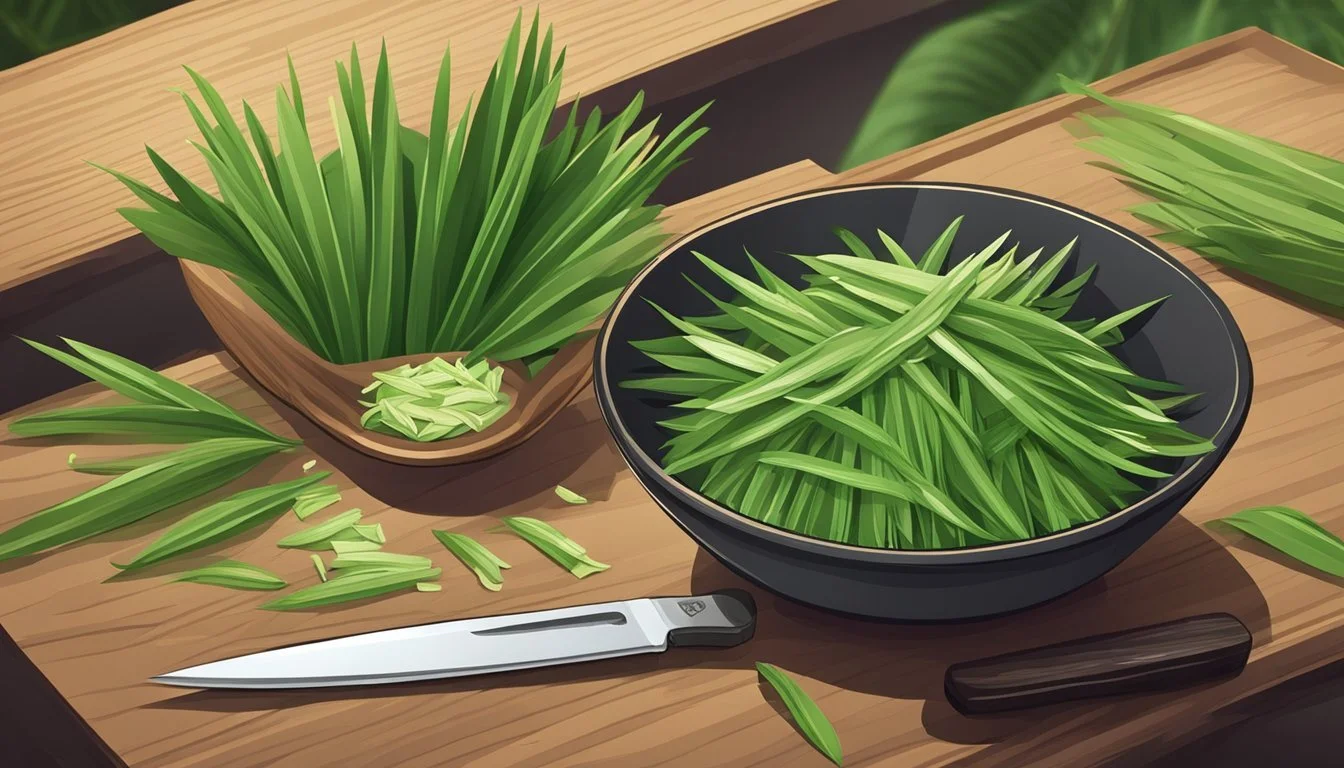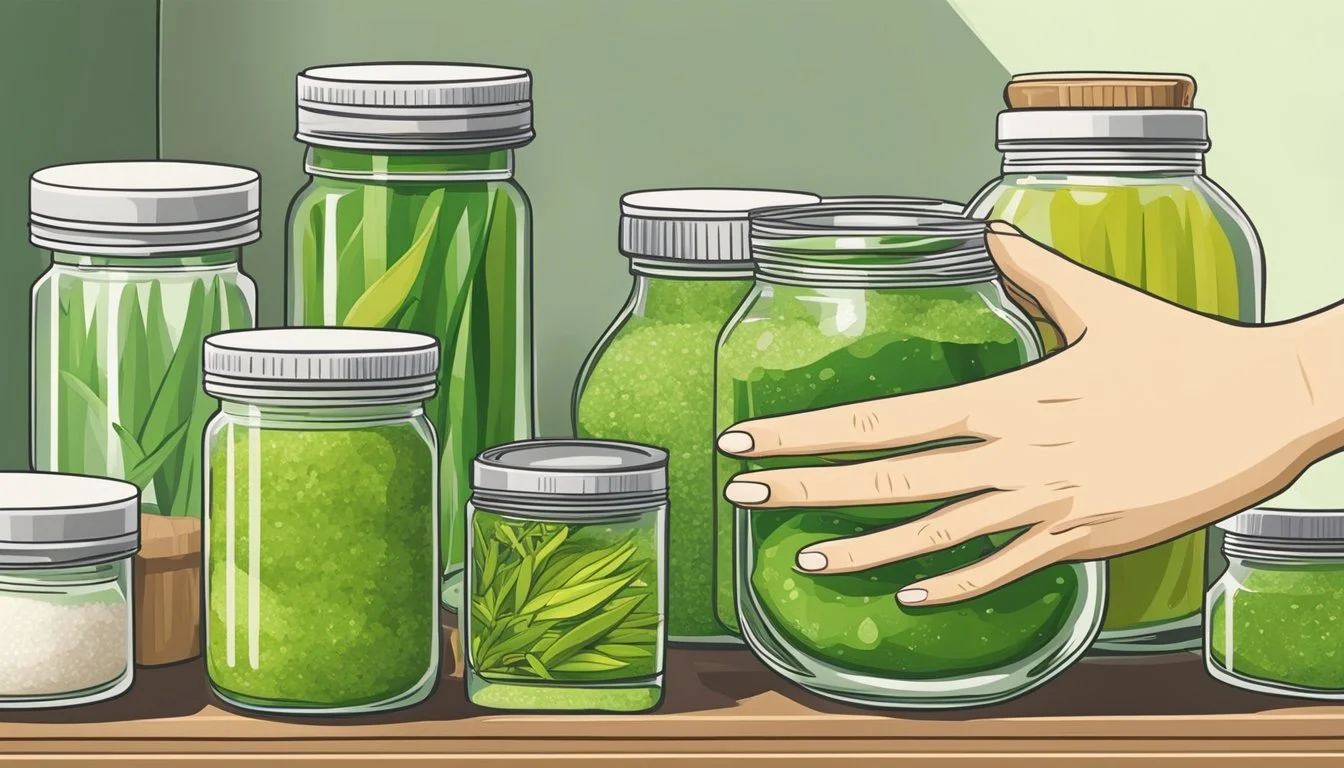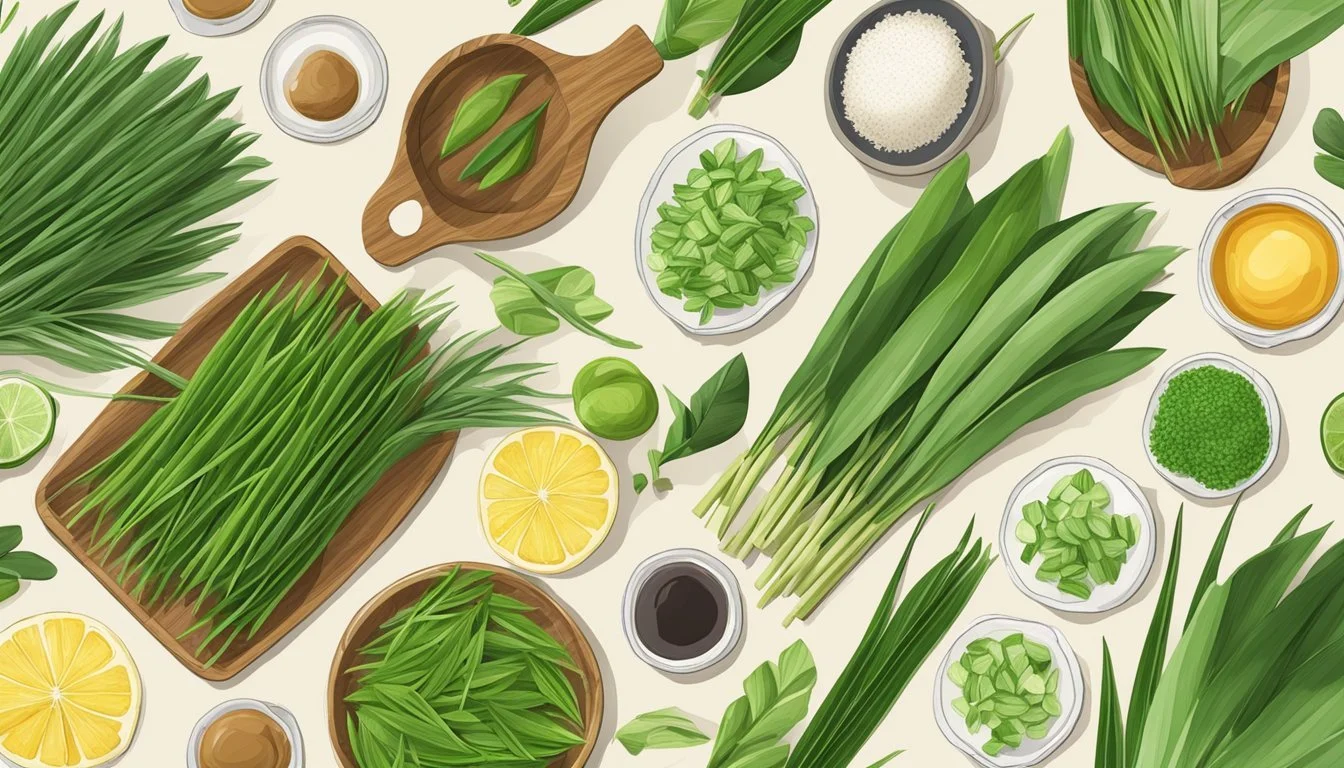Pandan Leaves Substitutes
Best Alternatives for Recipes
Pandan leaves are a staple in Southeast Asian cuisine, known for their distinctive aroma, flavor, and vibrant green color. Their unique qualities can be difficult to replicate, but for those unable to find pandan leaves, there are a number of suitable substitutes that can mimic some aspects of their taste and appearance. These alternatives enable home cooks to explore a variety of dishes without compromising too much on flavor or presentation.
For a substitute that captures the aromatic essence of pandan, vanilla extract or paste is a practical option. One of the primary flavor notes of pandan is reminiscent of vanilla, making this common pantry item a convenient replacement. In savory dishes, celery leaves can also be utilized due to their similar dark green color and distinctive taste, though they won't work as well in sweet recipes.
Ginger, with its sweet and peppery flavors, can stand in for pandan leaves in numerous dishes, adding a comparable depth and complexity. Matcha tea is another excellent substitute, especially for those looking to achieve a similar green hue while introducing a slightly different, but still harmonious, flavor profile to their dishes. By understanding and utilizing these substitutes, cooks can continue to create diverse and flavorful meals even in the absence of pandan leaves.
Understanding Pandan Leaves
Pandan leaves are a staple in Southeast Asian cuisine, valued for their unique aroma, flavor, and ability to impart a vibrant green color to dishes. They are used in both savory and sweet recipes, making them versatile in cooking.
Origins and Uses in Southeast Asian Cuisine
Pandan leaves, also known as Pandanus amaryllifolius, are widely used in Southeast Asian culinary traditions. These leaves are indigenous to regions like Thailand, Malaysia, Indonesia, and the Philippines.
In these cultures, pandan leaves are often added to rice while cooking to infuse it with a fragrant aroma. They are also used to wrap meats and desserts, acting as a natural flavoring agent. Additionally, pandan leaves play a crucial role in making traditional sweets, such as pandan cake and kuih, a type of Malaysian dessert.
Culinary Characteristics: Aroma, Flavor, and Color
The aroma of pandan leaves is unmistakable: a blend of grassy, floral, and nutty scents. This makes it a popular ingredient in both savory dishes and desserts. The leaves impart a unique flavor resembling a mix of vanilla and coconut, earning them the nickname "Asian vanilla."
In addition to aroma and flavor, pandan leaves are celebrated for their ability to add a vibrant green color to various dishes. This is particularly valued in making visually appealing desserts and drinks. Whether used fresh, frozen, or as an extract, the leaves bring an essential component to Southeast Asian cooking, enhancing both the taste and appearance of meals.
Pandan Leaves in Recipes
Pandan leaves impart a distinct aroma and color to various dishes, making them a favorite ingredient in many culinary traditions. They are often used in both traditional and modern recipes, either fresh, frozen, or in extract form.
Traditional Pandan-Based Dishes
Rice Dishes: Pandan leaves are widely used in rice dishes like Nasi Lemak and Nasi Pandan. The leaves are often tied into knots and cooked with the rice to infuse a fragrant aroma. This practice is common in Southeast Asian cuisine.
Desserts and Cakes: Pandan is a key ingredient in many traditional desserts such as Pandan Chiffon Cake, seri muka (layered rice cake), and puddings. Pandan essence, extracted from the leaves, is commonly used to flavor and color these sweet treats. Ice cream flavored with pandan is also a popular dessert in this region.
Sweet Treats: Besides cakes, pandan leaves are used in traditional puddings such as bubur sumsum. Pandan-infused coconut milk is a staple in making these desserts aromatic and delicious.
Incorporating Pandan into Modern Cooking
Baking: Modern baking often incorporates pandan essence for a unique twist in cakes and pastries. It's an excellent way to introduce a Southeast Asian flavor into Western recipes, from cupcakes to macarons.
Frozen Leaves and Extracts: Many cooks use frozen pandan leaves or pandan extract when fresh leaves aren't available. These alternatives ensure that the distinct flavor is present in dishes regardless of location.
Savory Dishes: Beyond desserts, pandan is also featured in modern savory dishes. It's not uncommon to see pandan-flavored sauces or marinades for meats and vegetables.
Innovative Desserts: Modern chefs create ice creams and puddings infused with pandan, blending creative techniques with traditional flavors. Pandan's unique taste and vibrant green color make it an attractive addition to a variety of contemporary desserts.
Top Substitutes for Pandan Leaves
When fresh or frozen pandan leaves are unavailable, there are several effective substitutes that can mimic both their flavor and color. Below are some of the most recommended alternatives.
Vanilla as the Primary Alternative
Vanilla shares a key flavor note with pandan, making it a fitting replacement. Vanilla extract is commonly recommended for its ease of use. A few drops can infuse dishes with a sweet, aromatic quality similar to pandan.
For a more robust flavor, vanilla beans can be used. Scraping the seeds out of a vanilla bean and mixing them into your recipe can closely mimic the flavor profile of pandan. Vanilla paste is another option that combines the convenience of extract with the intensity of bean seeds. Despite vanilla's widespread availability, it's worth noting that the substitution works best in desserts and sweet dishes rather than savory ones.
Green Tea and Matcha for Color and Aroma
Matcha tea and green tea can serve as color substitutes when the vibrant green hue of pandan is essential. Matcha powder is particularly effective due to its concentrated nature. A small amount mixed into cakes, ice creams, or beverages can replicate pandan’s signature green color while adding a subtle, earthy flavor.
Green tea leaves, when steeped, can offer both a light green tint and a mild, grassy note that complements many dishes. This is especially useful in recipes where the visual appeal of pandan is as important as its flavor. Matcha tea and green tea are not only good for their color but also contribute unique aromas that can enhance overall dish presentation.
Using Pandan Substitutes in Specific Dishes
When using pandan substitutes, it's crucial to match the flavors and properties of the substitute to the specific type of dish you're preparing. Here's how you can adapt these substitutes effectively in various culinary contexts.
Adapting Substitutes for Sweet Applications
In desserts and sweet dishes like cakes, ice creams, and smoothies, substitutes like vanilla extract can be effective. Vanilla provides a similar aromatic note that blends well with sweetness. Pandan extract or paste can also replicate the flavor more accurately if available.
For baked goods, matcha tea offers a unique twist with a mild earthy flavor and a vibrant green color. It's suitable for cakes and cookies, providing a visual and flavor profile similar to pandan.
Utilizing Substitutes in Savory Cooking
When it comes to savory dishes such as soups, salads, and steamed recipes, kaffir lime leaves are an excellent choice. These leaves add a citrusy and slightly floral note that complements many Southeast Asian cuisines.
Celery leaves work well in soups and sauces. Their slight bitterness and greenery mimic the essence of pandan without overpowering the dish.
For recipes that require a hint of spiciness, fresh ginger can also be used to replace pandan leaves. It offers a sweet and peppery flavor that enhances the complexity of savory dishes.
Non-Culinary Uses of Pandan and Its Substitutes
Pandan leaves are known not only for their role in the kitchen but also for their aesthetic, medicinal, and cultural applications. Their substitutes can often replicate these uses effectively.
Aesthetic and Medicinal Applications
Pandan leaves are widely admired for their vibrant green pigment, often used in natural dyes. The chlorophyll content is responsible for this intense coloration. These leaves can be used in various crafts, adding color to fabric or paper.
Medicinally, pandan leaves have aromatic properties believed to be soothing. They are used in traditional remedies for conditions like arthritis and joint pain, often in topical applications or teas. Some substitutes, like celery leaves, also contain medicinal properties, albeit different, such as anti-inflammatory benefits.
Substitutes like matcha tea and ginger can provide similar health benefits. Matcha, rich in antioxidants, is used in cosmetic products for its skin-enhancing properties. Ginger, another substitute, is noted for its anti-inflammatory and digestive benefits.
Cultural Significance Beyond the Kitchen
Pandan leaves hold significant cultural value in many Southeast Asian communities. They are used in rituals, ceremonies, and as natural air fresheners due to their soothing aroma. Pandan leaves sometimes act as a base for orchid arrangements, enhancing the visual and aromatic appeal.
Certain substitutes like celery leaves and ginger also play cultural roles. Celery is used in some Mediterranean customs, and ginger has long been a staple in traditional ceremonies and remedies across Asia. These substitutes can often serve similar ceremonial or aesthetic purposes when pandan is unavailable.
Pandan's diverse applications and its substitutes highlight their unique and versatile characteristics outside the culinary world.
Selecting and Storing Pandan Substitutes
Replacing pandan leaves in recipes involves both selecting the right ingredients and knowing how to store them properly. Here are key aspects to consider when choosing and preserving pandan substitutes.
Criteria for Choosing the Right Substitute
When selecting a substitute for pandan leaves, consider the intended use, whether it’s for a savory dish, a sweet dessert, or a beverage. Vanilla extract is often used because it shares similar flavor notes. For savory dishes, celery leaves can be a good alternative due to their mild bitterness. Meanwhile, matcha tea can add both color and a unique flavor.
Another criteria is the texture and form. Pandan paste or extract works well in both sweet and savory applications. Availability is also crucial; fresh, frozen, or bottled alternatives may be easier to find depending on your location.
Table: Substitutes and Their Best Uses
Substitute Best For Vanilla extract Sweet dishes, beverages Celery leaves Savory dishes Matcha tea Sweet dishes, beverages Pandan paste Sweet and savory dishes
Preservation Techniques for Substitutes
Proper storage is essential to maintain the quality of pandan substitutes. Vanilla extract should be kept in a cool, dark place and tightly sealed. Matcha tea requires airtight containers to prevent moisture and light from degrading its quality. It’s best stored in the refrigerator if you plan to keep it for an extended period.
Celery leaves can be stored in the refrigerator, wrapped in a damp paper towel within a plastic bag to maintain freshness. For pandan paste or extract, store the bottle in a cool cupboard, sealing it tightly to prevent exposure to air and light.
For those using frozen pandan leaves, ensure they remain in an airtight freezer bag to avoid freezer burn. Dried leaves should be stored in a sealed container in a dry, cool place.
Storage Tips Summary
Vanilla Extract: Cool, dark place
Matcha Tea: Airtight container, refrigerated
Celery Leaves: Wrapped in damp paper towel, refrigerated
Pandan Paste: Sealed in cool cupboard
Frozen Leaves: Airtight freezer bag
Dried Leaves: Sealed container, dry and cool place
Considerations for Cooking with Substitutes
When substituting pandan leaves in recipes, it's crucial to balance flavors and understand the impact on food color. Some substitutes offer similar grassy and slightly bitter tastes, but none perfectly mimic the pandan leaf's green hue.
Balancing Flavors and Aromas
Flavors and aromas are essential when choosing a pandan leaf substitute. Some common substitutes include vanilla extract, ginger, and celery leaves. Vanilla extract provides a sweet undertone, enhancing desserts and sweet dishes.
On the other hand, ginger offers a peppery taste that suits savory dishes well. Celery leaves can provide a mildly bitter flavor similar to pandan leaves but may be less effective in sweet recipes. Balancing these flavors requires careful consideration of the dish's requirements and the distinct attributes each substitute brings.
Understanding the Impact on Food Color
Pandan leaves give dishes a unique green hue. When substituting, achieving the same color can be challenging. Matcha tea is an excellent option for maintaining the green color while adding a subtle earthy taste.
Using vanilla or ginger will not replicate the green hue and may alter the visual appeal of the dish. Though they impregnate their own flavors well, they fail to capture the vibrant color pandan leaves provide. Celery leaves are suitable for their slightly similar color but may need pairing with color-enhancing ingredients to achieve the desired green. Balancing these factors ensures both the flavor and appearance of the dish are preserved.







